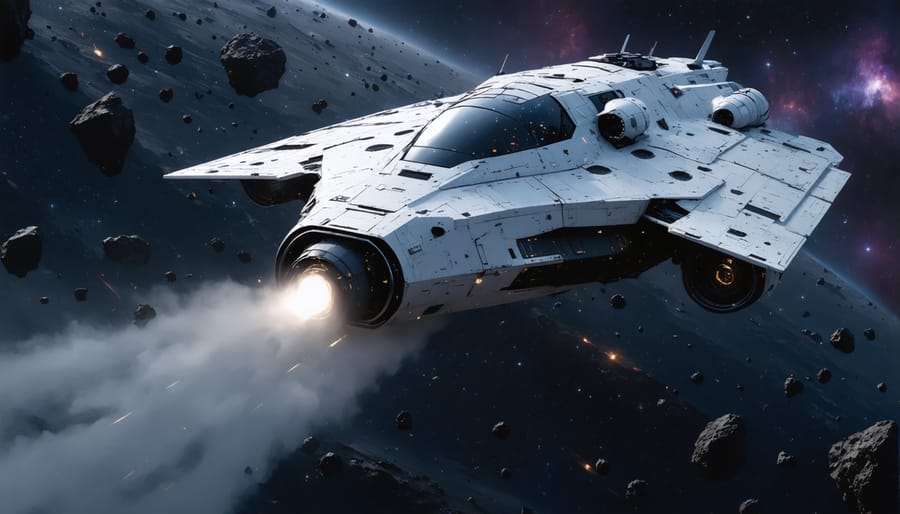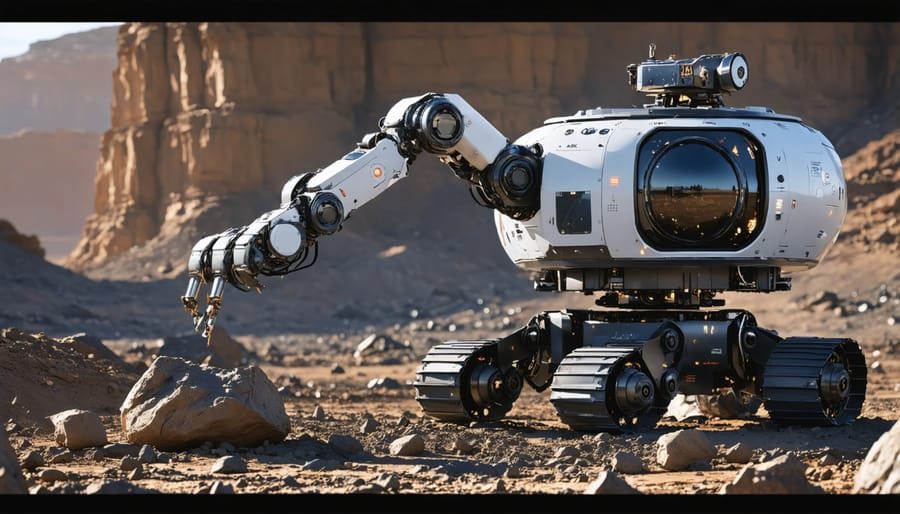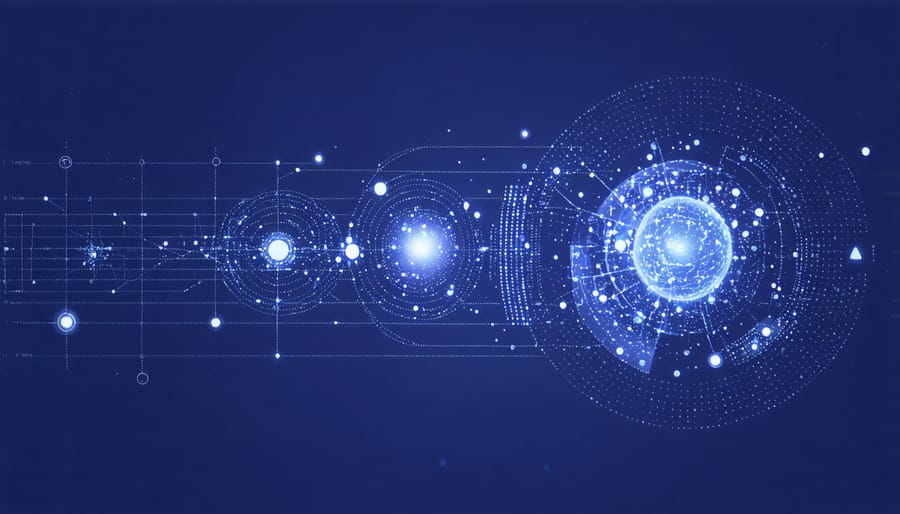Artificial intelligence is revolutionizing space exploration, transforming how we explore the cosmos from automated spacecraft navigation to the analysis of vast astronomical datasets. As NASA, SpaceX, and other space agencies increasingly rely on AI systems to tackle the complexities of deep space missions, we’re witnessing a fundamental shift in our approach to understanding the universe. These intelligent systems are not just tools; they’re becoming essential partners in humanity’s greatest adventure, enabling discoveries that were once thought impossible.
AI’s role in space exploration spans from autonomous rover operations on Mars to processing millions of telescope images in search of new exoplanets. Machine learning algorithms now predict solar flares with unprecedented accuracy, safeguarding astronauts and satellites, while neural networks help spacecraft make split-second decisions without waiting for signals from Earth. This marriage of artificial intelligence and space technology is opening new frontiers in our quest to explore the final frontier.
The impact is profound: missions that once required constant human oversight can now operate with greater independence and efficiency, pushing the boundaries of what’s possible in space exploration. As we stand on the cusp of a new space age, AI isn’t just enhancing our capabilities—it’s fundamentally redefining our relationship with the cosmos.
How AI is Revolutionizing Space Mission Control
Autonomous Navigation Systems
Space exploration presents unique challenges that require sophisticated navigation systems capable of making split-second decisions without human intervention. Modern spacecraft rely on adaptive AI systems to navigate through the vast emptiness of space while avoiding potential hazards like space debris, radiation storms, and unexpected astronomical objects.
These AI-powered navigation systems use a combination of sensors, cameras, and sophisticated algorithms to create real-time maps of their surroundings. Much like self-driving cars on Earth, spacecraft equipped with AI can detect and respond to obstacles automatically, calculating optimal trajectories that balance safety, fuel efficiency, and mission objectives.
NASA’s Mars rovers demonstrate this technology in action. When traversing the Martian surface, these robotic explorers must independently evaluate terrain, identify safe paths, and avoid hazards like steep slopes or loose sand. The AI processes visual and sensor data to make thousands of navigation decisions per second, far faster than Earth-based controllers could respond.
Recent advances in machine learning have also enabled spacecraft to learn from experience, improving their navigation capabilities over time. This is particularly valuable for deep space missions where communication delays with Earth make remote control impractical. By combining computer vision, sensor fusion, and predictive modeling, these systems ensure our robotic explorers can safely venture further into the unknown reaches of space.

Predictive Maintenance and Risk Assessment
In space exploration, where the smallest malfunction can lead to mission failure, AI-driven system management has become crucial for spacecraft maintenance and risk assessment. Modern space vehicles are equipped with thousands of sensors that continuously monitor everything from engine performance to life support systems, generating massive amounts of data every second.
AI algorithms process this data in real-time, identifying patterns that might indicate potential problems before they become critical. For example, on the International Space Station, AI systems analyze vibration patterns in mechanical components to detect early signs of wear and tear, much like how a doctor listens to a patient’s heartbeat to assess their health.
These predictive maintenance systems can forecast when components might fail, allowing ground crews to schedule repairs or replacements before emergencies occur. The AI monitors multiple parameters simultaneously – temperature fluctuations, pressure changes, power consumption patterns, and structural integrity – creating a comprehensive health profile of the spacecraft.
What makes this technology particularly valuable is its ability to learn from experience. Each mission adds to the AI’s knowledge base, improving its prediction accuracy and risk assessment capabilities. This continuous learning helps protect both expensive equipment and, more importantly, the lives of astronauts aboard these vessels.
AI Robotics in Space Exploration
Mars Rovers and Their AI Brains
Mars rovers represent one of the most successful applications of AI in space exploration, serving as our robotic geologists on the Red Planet. These sophisticated machines, from Curiosity to the newer Perseverance, rely heavily on artificial intelligence to navigate Mars’ challenging terrain and conduct scientific investigations autonomously.
The rovers’ AI systems excel in several key areas. Their autonomous navigation capabilities allow them to plot safe paths across rocky terrain, avoiding hazards while conserving precious energy. Using computer vision and machine learning algorithms, they can identify interesting geological features and prioritize which rocks or soil samples warrant closer examination.
Perseverance, NASA’s most advanced rover, showcases particularly impressive AI capabilities. Its AutoNav system processes 3D terrain data in real-time, enabling the rover to travel up to 200 meters per day without waiting for commands from Earth. The rover’s PIXL instrument uses AI to detect subtle changes in rock composition, while its SHERLOC system employs machine learning to identify organic molecules that might indicate signs of ancient microbial life.
These AI systems are crucial because the time delay between Earth and Mars (ranging from 4 to 24 minutes) makes real-time human control impossible. The rovers must make immediate decisions about their safety and scientific operations independently, demonstrating how AI enables more efficient and productive space exploration missions.

Future of AI Robotic Explorers
The future of AI-powered space exploration is poised for remarkable breakthroughs, with several groundbreaking developments on the horizon. NASA and other space agencies are developing more autonomous rovers that can make complex decisions without waiting for commands from Earth, significantly reducing response times during critical missions.
One of the most exciting developments is the concept of swarm robotics, where multiple small AI-powered robots work together cooperatively. These swarms could explore vast areas of planetary surfaces, construct habitats, or repair spacecraft with minimal human intervention. Engineers are also working on self-repairing robots that can diagnose and fix their own mechanical issues, ensuring longer mission durations.
Machine learning systems are becoming increasingly sophisticated in their ability to identify interesting scientific phenomena. Future AI explorers will be able to prioritize their investigations based on scientific value, potentially leading to unexpected discoveries that human controllers might have missed.
The integration of quantum computing with AI systems promises to enhance space exploration capabilities dramatically. These advanced systems will process vast amounts of data in real-time, enabling robots to navigate treacherous terrains and analyze complex atmospheric conditions more effectively.
Perhaps most intriguingly, researchers are developing emotional intelligence capabilities for space robots, allowing them to better understand and respond to human needs during future crewed missions, creating a more collaborative relationship between human astronauts and their robotic assistants.
Data Analysis and Scientific Discovery

Pattern Recognition in Space Data
AI’s pattern recognition capabilities have revolutionized how we analyze vast amounts of space data, making discoveries that would take humans years to identify. Space telescopes and satellites generate terabytes of data daily, and AI algorithms excel at sifting through this information to spot meaningful patterns and anomalies.
One remarkable application is in the detection of exoplanets. AI systems analyze the subtle dimming of stars as planets pass in front of them, identifying potential new worlds that might have escaped human observation. These algorithms can process thousands of light curves simultaneously, dramatically accelerating the pace of planetary discovery.
In mission control, AI assists in analyzing telemetry data from spacecraft and satellites. By continuously monitoring thousands of sensor readings, AI systems can detect subtle anomalies that might indicate potential equipment failures or unusual space phenomena. This predictive capability helps space agencies prevent costly failures and extend the lifespan of space assets.
The technology has also proven invaluable in identifying celestial objects like galaxies, supernovae, and asteroids. Machine learning models trained on vast astronomical databases can classify newly observed objects with remarkable accuracy, helping astronomers focus their attention on the most interesting phenomena.
Recent advances in deep learning have enabled AI to identify complex patterns in radio telescope data, potentially helping in the search for extraterrestrial intelligence by detecting unusual signal patterns that differ from known natural phenomena.
Accelerating Space Research
Artificial Intelligence has become a game-changer in space research, dramatically reducing the time needed to analyze vast amounts of data from telescopes, satellites, and space missions. What once took scientists months or even years to process can now be accomplished in days or hours, thanks to machine learning advances.
For instance, AI algorithms have revolutionized how we detect exoplanets by quickly sifting through light curve data from space telescopes like Kepler and TESS. These systems can identify subtle patterns that might indicate the presence of planets orbiting distant stars, leading to numerous new discoveries that human researchers might have missed.
AI is also accelerating our understanding of cosmic phenomena through automated image analysis. When studying galaxies, black holes, or stellar formations, AI can process thousands of telescope images simultaneously, identifying patterns and anomalies that deserve closer scientific attention. This capability has led to the discovery of previously unknown galaxy clusters and rare celestial events.
Furthermore, AI helps scientists simulate complex space environments and predict space weather patterns. These simulations are crucial for protecting satellites and spacecraft from solar flares and other space hazards. By processing real-time data from multiple sources, AI systems can provide early warnings and help safeguard valuable space assets.
The Future of AI in Space Exploration
As we stand on the cusp of a new era in space exploration, artificial intelligence is poised to revolutionize how we explore the cosmos. Machine learning systems are becoming increasingly sophisticated, enabling more autonomous space missions and smarter decision-making capabilities in deep space operations.
One of the most exciting developments is the evolution of autonomous spacecraft navigation. Future missions will likely feature AI systems capable of making real-time decisions without waiting for instructions from Earth, particularly crucial for deep space exploration where communication delays can stretch to hours. These systems will be able to identify and avoid hazards, select safe landing sites, and even alter mission parameters based on unexpected discoveries.
AI-powered robotic assistants are expected to become standard components of space missions. These advanced robots will work alongside human astronauts, handling dangerous or repetitive tasks while adapting to new situations. They’ll be particularly valuable in establishing and maintaining lunar bases and Mars colonies, where they can perform maintenance, conduct experiments, and manage resource utilization systems with minimal human intervention.
The future also holds promise for AI in space data analysis. As our telescopes and sensors collect unprecedented amounts of information about distant planets, stars, and galaxies, machine learning algorithms will become essential in identifying patterns, anomalies, and potential discoveries that might otherwise go unnoticed. This could dramatically accelerate our understanding of the universe and potentially help us identify signs of extraterrestrial life.
Space habitat management is another area where AI will play a crucial role. Future space stations and planetary bases will rely on AI systems to maintain life support systems, optimize resource usage, and predict potential equipment failures before they occur. These systems will learn from experience and continuously improve their performance, making long-term space habitation safer and more sustainable.
Perhaps most intriguingly, AI might help us solve one of space exploration’s greatest challenges: manufacturing and repair in space. Advanced AI systems could oversee 3D printing operations to produce replacement parts or even entire structures using local materials, reducing the need for supply missions from Earth and making deep space missions more self-sufficient.
As AI technology continues to advance, we can expect to see even more innovative applications in space exploration. From improving communication systems to enhancing our ability to study distant worlds, artificial intelligence will be an indispensable tool in humanity’s journey to the stars.
Artificial Intelligence has fundamentally transformed our approach to space exploration, ushering in a new era of discovery and innovation. As we’ve seen throughout this article, AI technologies are revolutionizing everything from mission planning and spacecraft navigation to data analysis and robotic exploration. These advancements have not only made space missions more efficient and cost-effective but have also enabled us to push the boundaries of what’s possible in space exploration.
The integration of AI has proven particularly valuable in handling the enormous amounts of data generated by space missions, identifying potentially habitable exoplanets, and enabling autonomous decision-making in remote environments. These capabilities have become increasingly crucial as we venture further into the solar system and beyond.
Looking ahead, the future of AI in space exploration appears incredibly promising. We can expect to see more sophisticated autonomous systems, improved deep space navigation capabilities, and enhanced data processing methods. These developments will be essential for ambitious projects like establishing permanent bases on the Moon and Mars, mining asteroids, and conducting detailed studies of distant galaxies.
As AI technology continues to evolve, it will undoubtedly play an even more significant role in helping us understand the universe and our place within it. The synergy between human ingenuity and artificial intelligence is opening up possibilities that were once confined to the realm of science fiction, making space exploration more accessible, efficient, and exciting than ever before.

